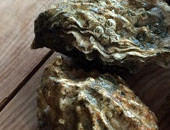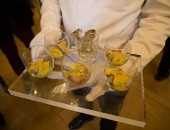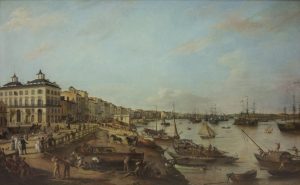The beginnings of the Bordeaux wine trade, and its connection to dynasties, politics and wealth in the Middle Ages by Rod Phillips
[time-restrict off="2015-04-17"]
In the world of wine, Bordeaux (as we now know the region) owns an unequalled position of prestige. Each growing season is watched carefully and narrated in detail, the quality of each vintage is discussed endlessly, and prices are tracked anxiously. Primeurs are tasted, futures are sold. More has been written on Bordeaux than any other wine region in the world. All this attention has grown over the years and it is not simply down to the quality of Bordeaux’s wines.
This is not to say that many Bordeaux wines are not of enviable quality, but the region’s pre-eminent position has never been left to the vagaries of such phenomena as the weather and the preferences of consumer taste. Although the term ‘brand-building’ was unknown to wine producers and merchants until the late twentieth century, it is what the Bordelais have been successfully engaged in since the Middle Ages.
Bordeaux was a relative late-comer to the wine business in France. Before Bordeaux became an important wine exporting region, the wines of Gascony and Acquitaine – large regions mainly to the south and east of Bordeaux – and nearby areas like Gaillac and Cahors found their way to the important English market. Through to the early twelfth century, these typically dark wines were shipped down rivers to Bordeaux, where they were trans-shipped to England and other destinations in northern Europe.
Bordeaux itself was not widely or intensively planted in vines at this time. What gave Bordeaux’s wine industry a boost were the dynastic arrangements that put Acquitaine and England under the same crown in the mid-1100s, thus facilitating commerce between them. In 1203, King John lowered the import duties on wine shipped from Bordeaux, in exchange for the city providing ships and other assistance for his war against the King of France. He promptly placed a big order for wine to show his support for the region.
Stimulated by the export opportunities, many of Bordeaux’s nobles – the Church was not nearly as involved in wine production in Bordeaux as it was in regions like Burgundy – began to plant vines. Vineyards had been concentrated around the city itself at first, and then in areas such as Graves and Entre-Deux Mers, but they began to fan out more widely, with the exception of Médoc, which was not intensively planted until it was drained in the 1600s. As production increased, Bordeaux’s winemakers adopted restrictive practices to protect their market. Wines from the interior – the dark wines that had established Bordeaux’s wine commerce with northern Europe – were banned from entering Bordeaux for trans-shipping until a fixed date each year, between mid-November and Christmas. This meant that the wines from areas closest to the city (what we now know as Bordeaux wines, and known as ‘claret’ because they were lighter in color) could be sold first. In effect, it was not until Bordeaux’s wines were sold that the wines from other parts of south-west France were permitted to enter the market.
The consequences were spectacular, and Bordeaux soon became a major producer and exporter. Sales to the English monarchy were key elements in this, as they gave Bordeaux’s wine cachet. Like other luxury commodities, they were sought after by nobles and wealthy commoners, who desired to drink the same wines as their social betters at court. The English court, meanwhile, was making significant purchases from Bordeaux. In 1243 alone, Henry III bought 1,445 casks of wine for £2,310. If they were the standard tun of 250 gallons, this represented some 1,655,000 litres, more than 2 million standard bottles. About two-thirds was described as top-quality wine, while the rest – no doubt destined as payment to the lower court staff – was mediocre and of poor quality.
So important was Bordeaux’s wine trade with England, that it survived the incorporation of the region into the kingdom of France. The trade was critical to the well-being of the Bordeaux economy, and instead of banning exports to the enemy – and alienating their new subjects – the French kings simply placed a tax on wine shipped to England. This had the effect of raising the price of claret on the English market, but the English elites remained faithful to it, even though they also bought wine from other regions of France (especially the Loire) and, over time, Spain and Portugal.
Claret remained important enough that even when France and England were at war, innovative methods were employed to ensure supplies to the English nobility and gentry. During the wars of the 1600s, trade was irregular, but it seemed that stable commerce would start again when regular commercial relations were re-established in 1697. But when trade was again interrupted in 1703, a strategy was devised by which French ships loaded with claret sailed close to the English coast, where they were seized by English privateers. The wine was taken to London, where it was auctioned, with the bulk of the proceeds going to the privateers who seem to have remitted part of their proceeds to the Bordeaux producers.
Vast volumes of premium Bordeaux wine thus reached the prime London market. In May 1705, for example, 200 barrels of Haut-Brion were auctioned. The following month, 230 barrels of Haut-Brion and Margaux went under the hammer, as did another 288 barrels from the same producers in the following weeks. These barrels sold for about £60 each, more than double the price paid for ordinary claret seized by privateers. The sums remitted to the Bordeaux producers must have been less than if they had sold the wine regularly, but this method of seizure-by-collusion kept claret in the all-important English market. The likes of John Hervey, the Earl of Bristol, recorded significant purchases of Margaux, Haut-Brion and Langon in this period, when trade in French wine was officially banned.
More recently, in the late 1800s, Bordeaux’s producers faced a different challenge, when their vineyards were devastated by phylloxera and they had to replant with vines on American rootstock. New vines on American roots did not sit well with the carefully constructed image of Bordeaux as an ancient and noble wine region, and one response was to create the Bordeaux ‘château’ - an image of nobility, stability and timelessness. In the 1855 Classification, only five properties bore the ‘château’ title, and it appeared on only four on an 1870 English list (Haut-Brion, Lafite, Latour and Margaux). As the list was reprinted, ‘château’ was added to more and more until, by the early 1900s, it was a standard designation, whether or not there was a château on the property.
The quality of Bordeaux’s wine and its appeal to the sensory preferences of the English elite clearly underlay its historical success, and lies behind its prestige today. But it is also clear, from these examples from different periods, that the continued prominence of Bordeaux wines rested on the commercial skills of Bordeaux’s producers and merchants.
The region has had its ups and downs, but the English market was always there to support it because of the addiction of the English upper classes to claret. The trade managed to continue one way or another even when France and England were at war.
In the world of wine, Bordeaux (as we now know the region) owns an unequalled position of prestige. Each growing season is watched carefully and narrated in detail, the quality of each vintage is discussed endlessly, and prices are tracked anxiously. Primeurs are tasted, futures are sold. More has been written on Bordeaux than any other wine region in the world. All this attention has grown over the years and it is not simply down to the quality of Bordeaux’s wines.
This is not to say that many Bordeaux wines are not of enviable quality, but the region’s pre-eminent position has never been left to the vagaries of such phenomena as the weather and the preferences of consumer taste. Although the term ‘brand-building’ was unknown to wine producers and merchants until the late twentieth century, it is what the Bordelais have been successfully engaged in since the Middle Ages.
.../continued...you need to upgrade your subscription if you wish to read this content.
In the world of wine, Bordeaux (as we now know the region) owns an unequalled position of prestige. Each growing season is watched carefully and narrated in detail, the quality of each vintage is discussed endlessly, and prices are tracked anxiously. Primeurs are tasted, futures are sold. More has been written on Bordeaux than any other wine region in the world. All this attention has grown over the years and it is not simply down to the quality of Bordeaux’s wines.
This is not to say that many Bordeaux wines are not of enviable quality, but the region’s pre-eminent position has never been left to the vagaries of such phenomena as the weather and the preferences of consumer taste. Although the term ‘brand-building’ was unknown to wine producers and merchants until the late twentieth century, it is what the Bordelais have been successfully engaged in since the Middle Ages.
.../continued...you need to subscribe to be able to view content from Fine Wine magazine.
Subscribe HERE to Fine Wine magazine to read the rest of this content or log yourself in if you are already a member.
[/time-restrict]
[time-restrict on="2015-04-18"]
In the world of wine, Bordeaux (as we now know the region) owns an unequalled position of prestige. Each growing season is watched carefully and narrated in detail, the quality of each vintage is discussed endlessly, and prices are tracked anxiously. Primeurs are tasted, futures are sold. More has been written on Bordeaux than any other wine region in the world. All this attention has grown over the years and it is not simply down to the quality of Bordeaux’s wines.
This is not to say that many Bordeaux wines are not of enviable quality, but the region’s pre-eminent position has never been left to the vagaries of such phenomena as the weather and the preferences of consumer taste. Although the term ‘brand-building’ was unknown to wine producers and merchants until the late twentieth century, it is what the Bordelais have been successfully engaged in since the Middle Ages.
Bordeaux was a relative late-comer to the wine business in France. Before Bordeaux became an important wine exporting region, the wines of Gascony and Acquitaine – large regions mainly to the south and east of Bordeaux – and nearby areas like Gaillac and Cahors found their way to the important English market. Through to the early twelfth century, these typically dark wines were shipped down rivers to Bordeaux, where they were trans-shipped to England and other destinations in northern Europe.
Bordeaux itself was not widely or intensively planted in vines at this time. What gave Bordeaux’s wine industry a boost were the dynastic arrangements that put Acquitaine and England under the same crown in the mid-1100s, thus facilitating commerce between them. In 1203, King John lowered the import duties on wine shipped from Bordeaux, in exchange for the city providing ships and other assistance for his war against the King of France. He promptly placed a big order for wine to show his support for the region.
Stimulated by the export opportunities, many of Bordeaux’s nobles – the Church was not nearly as involved in wine production in Bordeaux as it was in regions like Burgundy – began to plant vines. Vineyards had been concentrated around the city itself at first, and then in areas such as Graves and Entre-Deux Mers, but they began to fan out more widely, with the exception of Médoc, which was not intensively planted until it was drained in the 1600s. As production increased, Bordeaux’s winemakers adopted restrictive practices to protect their market. Wines from the interior – the dark wines that had established Bordeaux’s wine commerce with northern Europe – were banned from entering Bordeaux for trans-shipping until a fixed date each year, between mid-November and Christmas. This meant that the wines from areas closest to the city (what we now know as Bordeaux wines, and known as ‘claret’ because they were lighter in color) could be sold first. In effect, it was not until Bordeaux’s wines were sold that the wines from other parts of south-west France were permitted to enter the market.
The consequences were spectacular, and Bordeaux soon became a major producer and exporter. Sales to the English monarchy were key elements in this, as they gave Bordeaux’s wine cachet. Like other luxury commodities, they were sought after by nobles and wealthy commoners, who desired to drink the same wines as their social betters at court. The English court, meanwhile, was making significant purchases from Bordeaux. In 1243 alone, Henry III bought 1,445 casks of wine for £2,310. If they were the standard tun of 250 gallons, this represented some 1,655,000 litres, more than 2 million standard bottles. About two-thirds was described as top-quality wine, while the rest – no doubt destined as payment to the lower court staff – was mediocre and of poor quality.
So important was Bordeaux’s wine trade with England, that it survived the incorporation of the region into the kingdom of France. The trade was critical to the well-being of the Bordeaux economy, and instead of banning exports to the enemy – and alienating their new subjects – the French kings simply placed a tax on wine shipped to England. This had the effect of raising the price of claret on the English market, but the English elites remained faithful to it, even though they also bought wine from other regions of France (especially the Loire) and, over time, Spain and Portugal.
Claret remained important enough that even when France and England were at war, innovative methods were employed to ensure supplies to the English nobility and gentry. During the wars of the 1600s, trade was irregular, but it seemed that stable commerce would start again when regular commercial relations were re-established in 1697. But when trade was again interrupted in 1703, a strategy was devised by which French ships loaded with claret sailed close to the English coast, where they were seized by English privateers. The wine was taken to London, where it was auctioned, with the bulk of the proceeds going to the privateers who seem to have remitted part of their proceeds to the Bordeaux producers.
Vast volumes of premium Bordeaux wine thus reached the prime London market. In May 1705, for example, 200 barrels of Haut-Brion were auctioned. The following month, 230 barrels of Haut-Brion and Margaux went under the hammer, as did another 288 barrels from the same producers in the following weeks. These barrels sold for about £60 each, more than double the price paid for ordinary claret seized by privateers. The sums remitted to the Bordeaux producers must have been less than if they had sold the wine regularly, but this method of seizure-by-collusion kept claret in the all-important English market. The likes of John Hervey, the Earl of Bristol, recorded significant purchases of Margaux, Haut-Brion and Langon in this period, when trade in French wine was officially banned.
More recently, in the late 1800s, Bordeaux’s producers faced a different challenge, when their vineyards were devastated by phylloxera and they had to replant with vines on American rootstock. New vines on American roots did not sit well with the carefully constructed image of Bordeaux as an ancient and noble wine region, and one response was to create the Bordeaux ‘château’ - an image of nobility, stability and timelessness. In the 1855 Classification, only five properties bore the ‘château’ title, and it appeared on only four on an 1870 English list (Haut-Brion, Lafite, Latour and Margaux). As the list was reprinted, ‘château’ was added to more and more until, by the early 1900s, it was a standard designation, whether or not there was a château on the property.
The quality of Bordeaux’s wine and its appeal to the sensory preferences of the English elite clearly underlay its historical success, and lies behind its prestige today. But it is also clear, from these examples from different periods, that the continued prominence of Bordeaux wines rested on the commercial skills of Bordeaux’s producers and merchants.
The region has had its ups and downs, but the English market was always there to support it because of the addiction of the English upper classes to claret. The trade managed to continue one way or another even when France and England were at war.
Previously restricted content on finewinemagazine.com. This content was unrestricted on 18 April, 2015. Join our members who can view this content by clicking HERE[/time-restrict]











